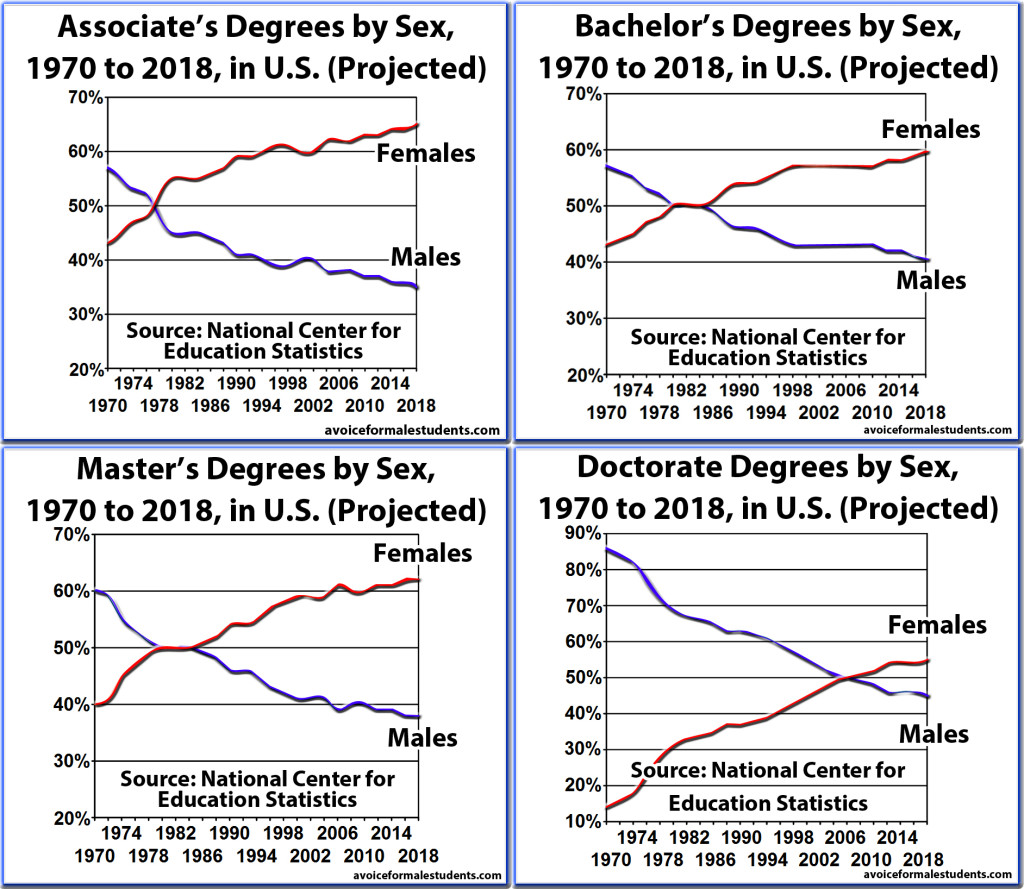Welcome, dear readers. School is now in session. Before we begin the lecture please do a brief preclass exercise by spending a minute taking a hard look at this set of graphs on graduation rates by sex over the past forty years:
Source: National Center for Education Statistics, Digest of Education Statistics, Table 268.
See more AVFMS graphs here.
Now let us begin.
One of the most persistent deflection tactics used by opponents of men’s and boys’ education is that while male students are falling well behind girls on the vast majority of educational metrics (enrollments, graduations, discipline referrals, dropouts, learning disabilities, suicides, social engagement, and so forth), they are still the majority of those who earn degrees in STEM fields (science, technology, engineering, math).
These degrees, the detractors argue, turn out to be more lucrative than humanities degrees, which women tend to select. Therefore the disparities between male and female students in virtually every other metric is really “not a big deal,” no matter how big those gaps become.
The claim is fallacious for several reasons. First, just because a few men do very well and some women do “on average” in the education-to-economics conversion doesn’t mean we should ignore the huge numbers of men who don’t do nearly as well as those women and fall through the economic floor. This is the apex fallacy playing itself out again.
You’ll see the same reasoning when an “expert” on gender and diversity issues points to men at the top of society (who comprise less than 1% of men) as a means to dismiss men’s issues. “Men are CEOs and politicians – how could they be disadvantaged in any way?” The fact that men are also the majority sex at the bottom of society – among the homeless, the imprisoned, suicides, workplace injuries and fatalities, and so forth – is not something that factors into their worldview.
If they care so much about bringing men who are overrepresented at the top of society down, they might as well care as much about bringing men who are the majority sex at the bottom of society up. As is sung in Les Miserables, “look down and show some mercy if you can, look down – look down! – upon your fellow man.
Ah, but they generally don’t. And it’s not because they can’t see the fact that the homeless who live in a house of dust and the trash are overwhelmingly men. It’s because they simply don’t want to see.
There are other reasons why this “argument” about women in STEM (which isn’t really an argument as much as it is a deflection) is wrong. You can see me arguing them in my article last year about Dr. Khalifa at Michigan State University.
Today we see yet more evidence as to why the “but men are overrepresented in STEM” deflection is misguided, narrow-minded, and overblown. Coming to us from Randy Olson, a research assistant at Michigan State University (yes, the same university as Dr. Khalifa), we have this graph on bachelors degrees awarded by sex:

Here is the direct link to the NCES data (table 325). Randy’s analysis is well-worth reading:
[su_quote]Surprisingly to me, most of the STEM majors aren’t doing as bad gender disparity-wise as I expected. 40-45% of the degrees in Math, Statistics, and the Physical Sciences were conferred to women in 2012. Even better, a majority of Biology degrees in 2012 (58%) were earned by women. This data tells me that we don’t really have a STEM gender gap in the U.S.: we have an ET gender gap!
This ET gender gap has severe consequences. Computer Science and Engineering majors have stagnated at less than 10% of all degrees conferred in the U.S. for the past decade, while the demand for employees with programming and engineering skills continue to outpace the supply every year. Compare this to more woman-dominated majors such as Business and Health Professions, which comprise 1/3 of all college degrees in 2012 when combined.[/su_quote]
So yes: not only is the science/technology/engineering/math gap really a technology/engineering gap, but in those areas where there actually is a big gender gap in favor of men very few of those degrees are awarded anyway!
One of the cardinal intellectual sins of Feminism is taking a problem that has a grain of truth and blowing it out of proportion. The STEM gender gap is yet one more example. You see, whenever you throw that big set of graphs up in front of an audience (like I did at the beginning of this article), the detractors say “but ah, you have to break down those degrees and look at it from a more nuanced perspective!” They then trot out the deflection that men earn the majority of stem degrees.
But they never break down those STEM degrees the way they ask us to break down bachelor’s degrees. And now you know why: there is no radical disparity between men and women in STEM. There is only a significant gap in engineering and computer science – which barely anyone gets degrees in anyway.
That’s not to say there isn’t any issue at all for women in STEM fields…just that it’s not a crisis, and it’s certainly a rationalization for dismissing boys’ education issues out of hand, as so many “experts” do.
It’s hard for a lot of people to admit (and thankfully those who think this way are getting closer to retirement every day), but it’s not the 1950s anymore. 90% of women over 18 are not barefoot housewives. It’s the 21st century. It’s time to embrace the idea that both sexes have issues, rather than just one.
Those who can’t get on the right side of this debate and choose to obstruct the path of progress will not be able to do so for much longer. They will increasingly be called out and marginalized, as they deserve to be. As Bob Dylan sang many years ago, the times, they are a-changing!
Thank You for Reading
If you like what you have read, feel free to sign up for our newsletter here:
About the Author
Related Posts
Welcome, dear readers. School is now in session. Before we begin the lecture please do a brief preclass exercise by spending a minute taking a hard look at this set of graphs on graduation rates by sex over the past forty years:
Source: National Center for Education Statistics, Digest of Education Statistics, Table 268.
See more AVFMS graphs here.
Now let us begin.
One of the most persistent deflection tactics used by opponents of men’s and boys’ education is that while male students are falling well behind girls on the vast majority of educational metrics (enrollments, graduations, discipline referrals, dropouts, learning disabilities, suicides, social engagement, and so forth), they are still the majority of those who earn degrees in STEM fields (science, technology, engineering, math).
These degrees, the detractors argue, turn out to be more lucrative than humanities degrees, which women tend to select. Therefore the disparities between male and female students in virtually every other metric is really “not a big deal,” no matter how big those gaps become.
The claim is fallacious for several reasons. First, just because a few men do very well and some women do “on average” in the education-to-economics conversion doesn’t mean we should ignore the huge numbers of men who don’t do nearly as well as those women and fall through the economic floor. This is the apex fallacy playing itself out again.
You’ll see the same reasoning when an “expert” on gender and diversity issues points to men at the top of society (who comprise less than 1% of men) as a means to dismiss men’s issues. “Men are CEOs and politicians – how could they be disadvantaged in any way?” The fact that men are also the majority sex at the bottom of society – among the homeless, the imprisoned, suicides, workplace injuries and fatalities, and so forth – is not something that factors into their worldview.
If they care so much about bringing men who are overrepresented at the top of society down, they might as well care as much about bringing men who are the majority sex at the bottom of society up. As is sung in Les Miserables, “look down and show some mercy if you can, look down – look down! – upon your fellow man.
Ah, but they generally don’t. And it’s not because they can’t see the fact that the homeless who live in a house of dust and the trash are overwhelmingly men. It’s because they simply don’t want to see.
There are other reasons why this “argument” about women in STEM (which isn’t really an argument as much as it is a deflection) is wrong. You can see me arguing them in my article last year about Dr. Khalifa at Michigan State University.
Today we see yet more evidence as to why the “but men are overrepresented in STEM” deflection is misguided, narrow-minded, and overblown. Coming to us from Randy Olson, a research assistant at Michigan State University (yes, the same university as Dr. Khalifa), we have this graph on bachelors degrees awarded by sex:

Here is the direct link to the NCES data (table 325). Randy’s analysis is well-worth reading:
[su_quote]Surprisingly to me, most of the STEM majors aren’t doing as bad gender disparity-wise as I expected. 40-45% of the degrees in Math, Statistics, and the Physical Sciences were conferred to women in 2012. Even better, a majority of Biology degrees in 2012 (58%) were earned by women. This data tells me that we don’t really have a STEM gender gap in the U.S.: we have an ET gender gap!
This ET gender gap has severe consequences. Computer Science and Engineering majors have stagnated at less than 10% of all degrees conferred in the U.S. for the past decade, while the demand for employees with programming and engineering skills continue to outpace the supply every year. Compare this to more woman-dominated majors such as Business and Health Professions, which comprise 1/3 of all college degrees in 2012 when combined.[/su_quote]
So yes: not only is the science/technology/engineering/math gap really a technology/engineering gap, but in those areas where there actually is a big gender gap in favor of men very few of those degrees are awarded anyway!
One of the cardinal intellectual sins of Feminism is taking a problem that has a grain of truth and blowing it out of proportion. The STEM gender gap is yet one more example. You see, whenever you throw that big set of graphs up in front of an audience (like I did at the beginning of this article), the detractors say “but ah, you have to break down those degrees and look at it from a more nuanced perspective!” They then trot out the deflection that men earn the majority of stem degrees.
But they never break down those STEM degrees the way they ask us to break down bachelor’s degrees. And now you know why: there is no radical disparity between men and women in STEM. There is only a significant gap in engineering and computer science – which barely anyone gets degrees in anyway.
That’s not to say there isn’t any issue at all for women in STEM fields…just that it’s not a crisis, and it’s certainly a rationalization for dismissing boys’ education issues out of hand, as so many “experts” do.
It’s hard for a lot of people to admit (and thankfully those who think this way are getting closer to retirement every day), but it’s not the 1950s anymore. 90% of women over 18 are not barefoot housewives. It’s the 21st century. It’s time to embrace the idea that both sexes have issues, rather than just one.
Those who can’t get on the right side of this debate and choose to obstruct the path of progress will not be able to do so for much longer. They will increasingly be called out and marginalized, as they deserve to be. As Bob Dylan sang many years ago, the times, they are a-changing!
Thank You for Reading
If you like what you have read, feel free to sign up for our newsletter here:
About the Author
Related Posts
More from Title IX for All
Accused Students Database
Research due process and similar lawsuits by students accused of Title IX violations (sexual assault, harassment, dating violence, stalking, etc.) in higher education.
OCR Resolutions Database
Research resolved Title IX investigations of K-12 and postsecondary institutions by the Department of Education’s Office for Civil Rights (OCR).
Attorneys Directory
A basic directory for looking up Title IX attorneys, most of whom have represented parties in litigation by accused students.







